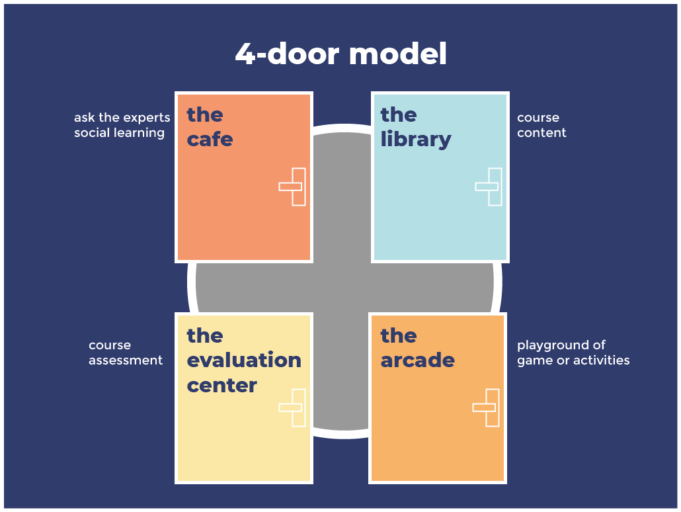A rapid eLearning development model that can be used to package existing content into a user friendly interface.
What is the 4-Door model?
Thiagi’s 4-Door eLearning approach is a simple way to construct an online course. The 4-door metaphor provides the learner with four sections that each serve a particular purpose.

- The Library — The actual content of the course
- The Arcade — A playground of small self-contained games or activities
- The Café — Access expert advice and engage in social learning activities
- The Evaluation Center — Performance test (job-related)
The aim of this approach is to provide an alternative to the linear style of traditional eLearning courses.
Why use 4-Door?
The 4-Door model is useful to both the learner and instructional designer.
The learner has freedom of choice in what to access. If they are a novice they might consume the content, practice and then take the assessment. While other learners might prefer to take the tests and then access the content to fill their knowledge gaps.
For instructional designers, the method provides a quick and cost effective way to produce a course. If you have a tight deadline and limited resources, existing learning materials can be included in the Library, with development focused on the quiz-based games and tests.
How can you apply the 4-Door model?
4-Door is best implemented by focusing on the final test, identifying or creating learning materials that build the required skills and knowledge to succeed in the test, and providing opportunities for practice and reflection.
The key part of the model is the final test. A good idea is to get your SME to identify the performance task and work backwards from that.
Your SME can help identify suitable content for the Library such as manuals, videos, marketing materials, documents, intranet articles, job aids, flow diagrams and organizational charts.
Next, use the Arcade to produce mini-games or activities that promote the reinforcement of learning by offering three levels of difficulty and unlimited attempts. This can also be used to identify gaps that learners can then fill by accessing the Library.
Populate the Café with opportunities for learners to reflect and allow learners to view model answers or behaviours. Use social learning platforms to allow additional support from peers and experts.
The content in the Library, the activities in the Arcade, and the reflection opportunities in the Café should then support the learner to successfully complete the final test in the form of an online evaluation or observable workplace assessment.
Review

Pros: Quick and cheap. Good alternative to linear courses.
Cons: Curation rather than robust instructional design. Risk of filling the Library with substandard materials. Can lead to lack of analysis in the design process.
Related reading: CCAF, SAM, Instructional Design
